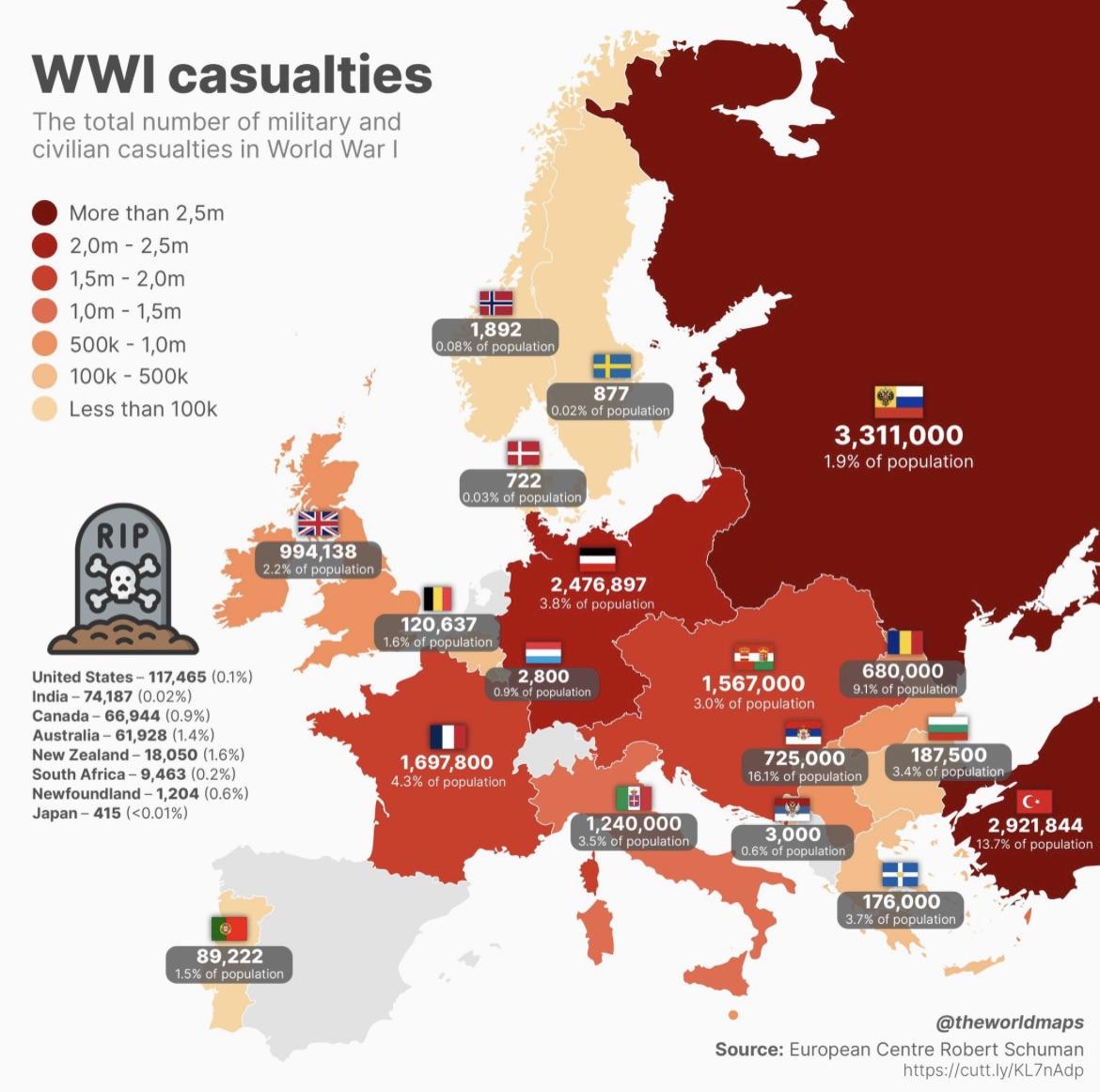Map of Countries that Lost the Most People in WW1


Alex Cartwright
Senior Cartographer & GIS Specialist
Alex Cartwright is a renowned cartographer and geographic information systems specialist with over 15 years of experience in spatial analysis and data...
Geographic Analysis
What This Map Shows
This map visually represents the devastating human cost of World War I by highlighting the countries that experienced the highest loss of life during the conflict. The stark figures displayed on the map serve as a reminder of the profound impact of war on populations and societies. Each country is marked according to the estimated number of military and civilian casualties, showcasing a tragic chapter in global history that reshaped borders and national identities.
Deep Dive into Casualties of World War I
World War I, often referred to as the Great War, was a cataclysmic event that lasted from 1914 to 1918 and involved many of the world’s great powers. The casualties were staggering, with estimates of around 16 million deaths and over 21 million wounded. The total losses included not only military personnel but also civilians caught in the crossfire, making it one of the deadliest conflicts in human history.
Interestingly, the countries that suffered the most significant losses were not only those involved in frontline battles but also those affected by occupation, famine, and disease. For example, Russia endured the highest number of casualties, with estimates suggesting around 3.3 million military and civilian deaths. The Russian Empire's entry into the war and subsequent internal turmoil, including the Russian Revolution, exacerbated the situation, leading to widespread suffering.
Germany, another central player in the war, faced approximately 2 million deaths. The war's end did not bring immediate relief; instead, the Treaty of Versailles imposed harsh penalties on Germany, further destabilizing the nation and contributing to the rise of extremist ideologies in the years that followed.
France, which saw intense fighting on its soil, reported around 1.4 million military deaths, alongside significant civilian casualties. The war left deep scars on the French landscape and psyche, leading to a reflection on the futility of the conflict in the years that followed.
Interestingly, the Ottoman Empire, which was a central power during the war, also faced catastrophic losses, with estimates of around 2.5 million deaths due to battles, famines, and the Armenian Genocide, which has been a point of contention and denial in historical narratives.
The scale and nature of these casualties illustrate the devastating impact of total war, where entire societies were mobilized and affected. The demographics of the countries involved shifted dramatically, with many losing a significant portion of their young male population, which would have long-lasting effects on social structures and economic development.
Regional Analysis
When we break down the map by regions, the differences in casualties become even more pronounced. In Europe, the Western Front saw some of the heaviest fighting, with countries like Belgium and France suffering immensely. Belgium, with a population of just over 7 million at the time, lost around 38% of its population due to the war, showcasing the war's brutal impact on smaller nations caught in the crossfire.
In the Balkans, the war’s effects were equally tragic, with Serbia losing an estimated 1.1 million people, which represented around 25% of its pre-war population. This loss severely impacted Serbia’s demographic structure and national identity, leading to long-term repercussions in the region.
In contrast, the United States, which joined the war later, had comparatively lower casualty figures of approximately 116,000 military deaths. However, the American involvement marked a significant shift in the war’s dynamics and ultimately contributed to the Allied victory.
What’s fascinating is that while many countries were devastated, others, like the United States and Japan, saw their global influence grow post-war despite sustaining fewer losses. This disparity highlights how the aftermath of World War I was not only about loss but also about the reshaping of power dynamics on the world stage.
Significance and Impact
Understanding the human costs of World War I is crucial, as it provides context for the geopolitical landscape that followed. The war's aftermath led to the redrawing of borders, the establishment of new nations, and significant political change across Europe and beyond. The sheer scale of the losses influenced international relations and military strategies for decades to come.
Moreover, the memory of these losses continues to resonate today, serving as a poignant reminder of the consequences of global conflict. Commemorations and memorials around the world pay tribute to those who lost their lives, emphasizing the importance of remembrance in preventing future wars.
In current times, as nations grapple with new forms of conflict and violence, reflecting on the devastating human toll of World War I can inform contemporary discussions about war, peace, and international diplomacy. The lessons learned from this period are essential as we face the complexities of modern global relations.
The map of countries that lost the most people during WW1 is not just a historical representation; it’s a powerful reminder of the cost of conflict and the necessity of striving for peace in our interconnected world.
Visualization Details
- Published
- August 18, 2025
- Views
- 114
Comments
Loading comments...